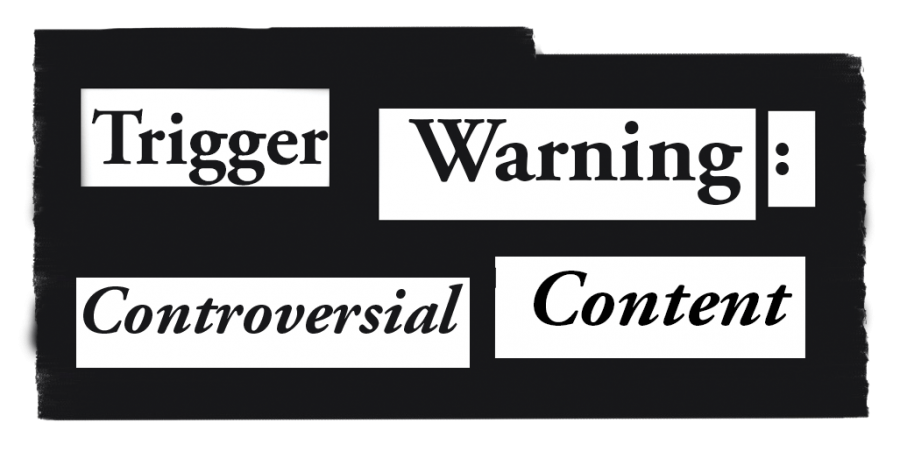Trigger Warning: Controversial Content
Students, teachers and professionals discuss benefits and drawbacks of implementing trigger warnings in the classroom
March 26, 2021
When India Spencer ’21 clicked on a Zoom link for the Community Flex Time webinar on Jan. 14, she anticipated that the school would acknowledge a trend of depleted mental health and hoped for a sensitive discussion to validate students’ struggles. Instead, she said she left the meeting feeling exhausted and overwhelmed after open discussion of mental illness with Lauren Lee ’20 and Jackie Greenberg ’19.
Students discuss the purpose of trigger warnings
“To be honest, the meeting was very overwhelming for me and some people I know,” Spencer said. “I’ve suffered from depression and self-harm, and going into the meeting, I wasn’t expecting that kind of material. I don’t think it was the best idea to have [former] students share in grim detail their mental health experiences, especially when [students] are all so isolated and clearly struggling. The assembly resulted in the rest of my energy that day being devoted to reliving things that I would rather not, especially when I am already feeling so alone. Having [those topics] thrown in your face with barely any warning can be extremely triggering.”
Like Spencer, Savannah Walske ’22 said the webinar was a problematic setting for exposure to and discussion of self-harm and suicide. Walske said considering they are incredibly sensitive topics, warnings should have been given prior to the meeting.
“I understand their intent was to raise awareness and make people know that they weren’t alone, but at the same time, people who have already overcome things such as self-harm don’t need to hear about it again,” Walske said. “Many self-harm victims can relapse as a result of such discussions, even if [the speaker’s] experience, in the end, was of a positive net benefit.”
The warnings Walske and Spencer wished had been utilized are often referred to as “trigger warnings.” Leslie Martin, a psychologist from Studio City who specializes in trauma treatment, said that triggers are any sensory input that may evoke a memory or reference a traumatic event in someone’s life that they are insufficiently coping with. In the media, trigger warnings are generally provided in the form of alerts before movies or temporarily blurred posts on Instagram, and they serve to alert audience members of potentially violent or sensitive content. A rising number of trigger warnings in 2013 sparked their further implementation in educational settings.
Trigger warnings benefit students in the classroom
Martin said she thinks there are educational settings where trigger warnings benefit students struggling with trauma or post traumatic stress disorder (PTSD) because it puts them in a position of management over their trauma; however, she recognizes the potential long-term complications of extreme accommodations for a student audience. Martin said she views education as a partnership and believes the issue of trauma management in the classroom falls on both the educator and the student.
“I think it’s incumbent on any good teacher to inform a student about what they’re about to encounter in an assignment, whether you’re reading the diary of Anne Frank coming from a family of Holocaust survivors, or there’s a rape scene, and there’s been some sexual trauma,” Martin said. “On the other hand, we don’t want to spoon-feed our students too much, so if you’re the child of a Holocaust survivor, do some research on the topic of the book. But I think it would be wildly irresponsible for a teacher not to say, ‘Just know this is coming, and if there’s an issue, come see me after class.’”
Psychology Teacher Michelle Bracken said that while in her own classroom, she often warns students before playing graphic or potentially disturbing videos, she finds it unrealistic to assume that she can protect everyone struggling with PTSD from every potential trigger of their personal trauma.
“I think with PTSD, images, sounds and smells can set you off and usually trigger those emotions, [but] there are so many different variables involved with the trauma that it’s hard to say,” Bracken said. “I think [trigger warnings] make the person giving [them] feel better because at least [they] tried to warn you about it, but I’m not sure [they’re] always as effective as we hope [they are]. For people who know what they’re afraid of or disturbed by, I think it helps on some level, but there isn’t anything you can do that’s 100% effective 100% of the time.”
There are negative effects to using trigger warnings in the classroom
Although teachers like Bracken support trigger warnings in some cases, Rafael Singer ’21 views the excessive use of trigger warnings as a practice to be wary of and believes that implementing them in schools will be problematic in the long run.
“I think the intentions behind trigger warnings come from a good place, wanting to protect distressed people from potentially traumatic ideas or perspectives,” Singer said. “However, I think the premise of trigger warnings is too idealistic, especially for school, and they actually have pretty adverse ramifications. I believe that it’s the function of school to expose its students to new and challenging perspectives, even if those might be offensive or hurtful. This teaches students how to cope with offensive material as well as broaden and complicate their world views.”
Singer expanded on his belief that trigger warnings are detrimental to the intellectual growth of students.
“I’m not fully sure if there are valid scenarios where trigger warnings have a wholly positive effect without dissuading people from grappling with differing ideas,” Singer said. “I think it’s generally good to understand how what you say might affect someone else, but trying to envelop students in protective bubble wrap with content warnings and labels just seems like a recipe for a less open and understanding society.”
Trigger warnings should be implemented in literature
In contrast to Singer’s wariness of trigger warnings, Walske believes that forewarning of sensitive content from teachers should be a more standardized practice. Walske said that while she has had teachers who were mindful of triggers, she has often experienced discomfort in situations where she feels a teacher has fallen short in addressing a sensitive topic.
“[In English] this year, [Tony Morrison’s] ‘Beloved’ had a lot of very violent themes, and for some people that could have been triggering to read about,” Walske said. “[My teacher] did mention to us before we started reading the book that there was violence, and it had dark themes, but he didn’t specify which themes they were, and it could have been really triggering to some people if they had similar experiences to the characters in the books. And when my history teacher last year talked about the Holocaust, he didn’t really seem to put much sensitivity into how he talked about it or consideration of people who might have pasts associated to that historical event.”
Walske believes such situations place students in uncomfortable learning environments and are counterproductive to their education.
“I don’t see how students should be expected to learn anything when they are triggered by something that they’re supposed to be learning about,” Walske said. “I really don’t think trigger warnings are that broad in their impact; it’s just preventing further trauma for most people, and you can still enjoy and reap the benefits of literature without having to be constantly triggered by sensitive topics.”
Studies examine the effectiveness of trigger warnings
Throughout the media and within the classroom, young people like Walske continue to call for the wider implementation of trigger warnings, prompting studies whose conclusions complicate the debate over whether or not they actually benefit their audiences.
While clinical research has generally endorsed the practice of trigger warnings, a 2017 study published by the American Psychology Association countered assumptions of the positive effects. The study concluded that the recipient does not benefit long-term by evading their triggers; rather, the practice is problematic in that it may exacerbate or prolong PTSD symptoms. Other studies featured in the Journal of Experimental Social Psychology examining the long-term effectiveness of trigger warnings similarly suggest that while warnings are proven to reduce immediate distress and make reactions more manageable for survivors, treatments like exposure therapy are far more effective than avoidance of one’s triggers.
Trigger warnings validate trauma
Walske said that while concerns of stunting the recovery of people struggling with PTSD are understandable, exposure therapy is not something that should be undergone in the classroom or through the media, but in an appropriate setting with a professional.
“There’s been discourse on social media about adding trigger warnings to food for people with eating disorders,” Walske said. “In that case, it does make sense to argue that putting a trigger warning on that reinforces the negative connotation of food. But I think with triggering things that aren’t connected to taking care of yourself, a social media app should not serve as your exposure therapy, and you should rather seek professional help. If you have PTSD, seeing and hearing [triggering things] on social media or in a class when you don’t intend to be exposed to [them] is just others disregarding [your] trauma, and in my mind is dismissive of others.”
Like Walske, Spencer believes the proper implementation of warnings in the classroom settings is important and said the practice should be taken more seriously. She also spoke against the increasingly lighthearted use of the word “trigger” and said using it in an inappropriate context invalidates and dismisses the struggles of students.
“I think that trigger warnings should always be announced way ahead of a lesson or community meeting to ensure that students know what they will be discussing and can either prepare for it or not go,” Spencer said. “Trigger warnings should be taken very seriously, and it angers me that the word ‘trigger’ has morphed into a joke. Treating triggers like a joke results in people who have experienced traumatic events feeling invalidated or [feeling as though] what they went through wasn’t a serious ordeal.”
































